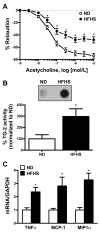Arterial stiffening precedes systolic hypertension in diet-induced obesity
- PMID: 24060894
- PMCID: PMC3951434
- DOI: 10.1161/HYPERTENSIONAHA.113.01744
Arterial stiffening precedes systolic hypertension in diet-induced obesity
Abstract
Stiffening of conduit arteries is a risk factor for cardiovascular morbidity. Aortic wall stiffening increases pulsatile hemodynamic forces that are detrimental to the microcirculation in highly perfused organs, such as the heart, brain, and kidney. Arterial stiffness is associated with hypertension but presumed to be due to an adaptive response to increased hemodynamic load. In contrast, a recent clinical study found that stiffness precedes and may contribute to the development of hypertension although the mechanisms underlying hypertension are unknown. Here, we report that in a diet-induced model of obesity, arterial stiffness, measured in vivo, develops within 1 month of the initiation of the diet and precedes the development of hypertension by 5 months. Diet-induced obese mice recapitulate the metabolic syndrome and are characterized by inflammation in visceral fat and aorta. Normalization of the metabolic state by weight loss resulted in return of arterial stiffness and blood pressure to normal. Our findings support the hypothesis that arterial stiffness is a cause rather than a consequence of hypertension.
Keywords: hypertension; inflammation; obesity; pulse wave velocity; vascular stiffness.
Conflict of interest statement
Conflict of interest/Disclosure: GM is the owner of Cardiovascular Engineering, Inc., a biomedical device manufacturer from which some instrumentation, used to conduct this study, was purchased.
Figures





Comment in
-
Cellular and molecular mechanisms of arterial stiffness associated with obesity.Hypertension. 2013 Dec;62(6):1003-4. doi: 10.1161/HYPERTENSIONAHA.113.01872. Epub 2013 Sep 23. Hypertension. 2013. PMID: 24060893 Free PMC article. No abstract available.
References
-
- Sutton-Tyrrell K, Najjar SS, Boudreau RM, Venkitachalam L, Kupelian V, Simonsick EM, Havlik R, Lakatta EG, Spurgeon H, Kritchevsky S, Pahor M, Bauer D, Newman A. Elevated aortic pulse wave velocity, a marker of arterial stiffness, predicts cardiovascular events in well-functioning older adults. Circulation. 2005;111:3384–3390. - PubMed
-
- Sutton-Tyrrell K, Newman A, Simonsick EM, Havlik R, Pahor M, Lakatta E, Spurgeon H, Vaitkevicius P. Aortic stiffness is associated with visceral adiposity in older adults enrolled in the study of health, aging, and body composition. Hypertension. 2001;38:429–433. - PubMed
-
- O'Rourke MF, Hashimoto J. Mechanical factors in arterial aging: A clinical perspective. J Am Coll Cardiol. 2007;50:1–13. - PubMed
-
- Beltran A, McVeigh G, Morgan D, Glasser SP, Neutel JM, Weber M, Finkelstein SM, Cohn JN. Arterial compliance abnormalities in isolated systolic hypertension. Am J Hypertens. 2001;14:1007–1011. - PubMed
Publication types
MeSH terms
Grants and funding
LinkOut - more resources
Full Text Sources
Other Literature Sources
Medical

